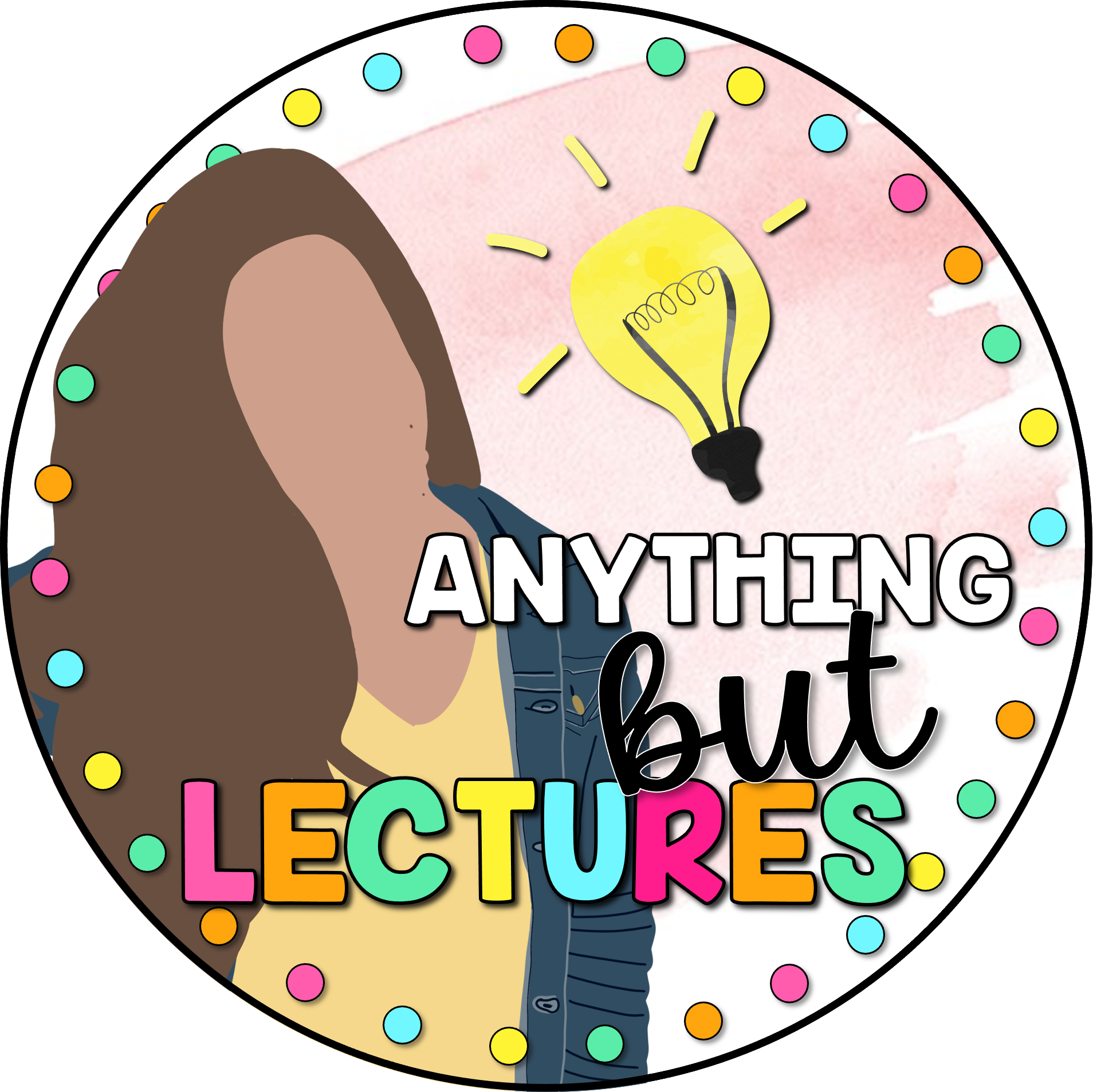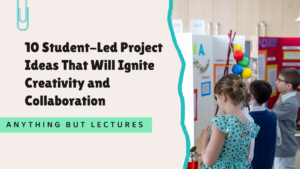In today’s rapidly changing world, fostering curiosity in the classroom has become more important than ever. As educators, one of our responsibilities is to ignite that curious spark in our students and encourage them to explore the world around them.
An inquisitive classroom environment not only helps students develop critical thinking skills but also fuels their passion for learning!

In this post, we will delve into the strategies and techniques you can employ to create a classroom that sparks curiosity. From incorporating inquiry-based learning methods to providing open-ended questions and hands-on activities, we will explore how to cultivate an environment that encourages students to ask questions, seek answers, and think critically.
Furthermore, we will delve into the role of technology in nurturing curiosity and discuss ways to incorporate it seamlessly in the classroom.
Let’s unravel the secrets to creating an inquisitive classroom environment that fosters a love for learning and empowers students to become lifelong learners!
The importance of fostering curiosity in the classroom
Curiosity is the driving force behind learning and discovery. When students are curious, they become active participants in the learning process, they ask questions, explore new ideas, and seek deeper understanding. In today’s rapidly changing world, fostering curiosity in the classroom is more important than ever! As educators, we have a responsibility to ignite the flame of curiosity within our students, empowering them to become lifelong learners.
By cultivating an inquisitive classroom environment, we can help students develop:
- Critical thinking skills
- Problem-solving abilities
- A genuine passion for learning.
Curious students are more engaged, motivated, and eager to explore the world around them. They are not content with simply memorizing facts and regurgitating information; instead, they strive to understand the underlying concepts, make connections, and apply their knowledge to real-world situations.
Furthermore, an inquisitive classroom environment prepares students for the challenges of the future. In a world that is constantly evolving, the ability to think critically, ask thoughtful questions, and adapt to new situations will be essential for success. By fostering curiosity, we are equipping our students with the tools they need to navigate the complexities of the 21st century and become active, engaged, and responsible citizens.

Benefits of an inquisitive classroom environment
When students are encouraged to be curious and ask questions, the benefits extend far beyond the classroom. An inquisitive classroom environment fosters a love of learning, empowers students to take ownership of their education, and develops a range of essential skills that will serve them well throughout their lives.
One of the primary benefits of an inquisitive classroom is that it promotes critical thinking and problem-solving skills. By encouraging students to ask questions, explore alternative perspectives, and seek out their own answers, we are helping them develop the ability to think critically and analyze information from multiple angles. This skill set is invaluable in a world where the ability to navigate complex problems and make informed decisions is increasingly important.
Moreover, an inquisitive classroom environment nurtures creativity and innovation. When students are free to explore their curiosities and pursue their interests, they are more likely to come up with novel ideas, think outside the box, and challenge the status quo. This fosters an environment where students are not afraid to take risks, experiment, and push the boundaries of their own understanding. As a result, they are better equipped to adapt to change, embrace new challenges, and contribute to the advancement of their fields.
Strategies for promoting curiosity in students
Fostering curiosity in the classroom requires a multifaceted approach that encompasses a range of strategies and techniques. As educators, we must be intentional in our efforts to create an environment that encourages students to ask questions, explore their interests, and engage in meaningful learning experiences.
One effective strategy for promoting curiosity is to incorporate inquiry-based learning methods into the classroom. This approach encourages students to take an active role in their learning by posing questions, conducting research, and drawing their own conclusions. By presenting students with open-ended problems or thought-provoking scenarios, we can inspire them to delve deeper, seek out information, and develop their critical thinking skills.
Click here to check out a recent post about the inquiry-based approach.
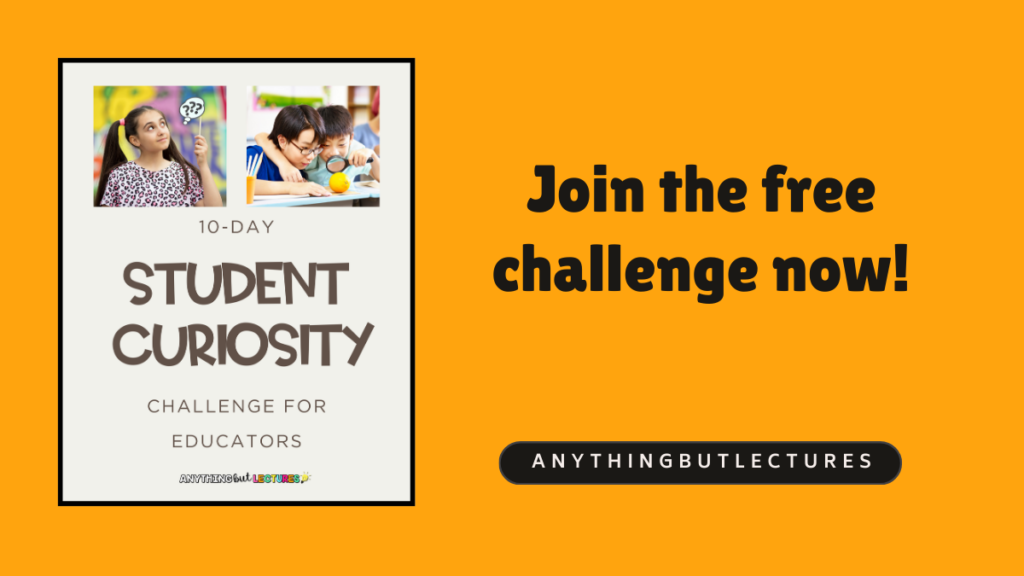
Another key strategy is to create a safe and supportive classroom culture that values curiosity and embraces the process of learning. This means fostering an environment where students feel comfortable expressing their ideas, asking questions, and making mistakes without fear of judgment or ridicule. By modeling curiosity ourselves and celebrating the curiosity of our students, we can help them develop the confidence and resilience to explore their interests and take intellectual risks.
Encouraging questioning and inquiry-based learning
Questioning is the cornerstone of an inquisitive classroom environment. By encouraging students to ask questions, we are not only fostering their curiosity but also helping them develop essential critical thinking and problem-solving skills.
One effective way to encourage questioning is to incorporate “question-storming” activities into the classroom. These activities involve presenting students with a thought-provoking topic or scenario and then challenging them to generate as many questions as possible, without judgment or evaluation. This helps students practice the art of questioning, encourages them to think deeply about the subject matter, and allows them to explore their own areas of interest.
Inquiry-based learning is another powerful strategy for promoting curiosity in the classroom. This approach involves guiding students through a process of investigation, where they are encouraged to pose their own questions, conduct research, and draw their own conclusions. By allowing students to take the lead in their learning, we empower them to explore their curiosities, engage in hands-on experimentation, and develop a deeper understanding of the subject matter.

Creating a safe and supportive classroom culture
Fostering an inquisitive classroom environment requires more than just implementing specific strategies; it also requires cultivating a classroom culture that values curiosity, embraces mistakes, and encourages students to take intellectual risks.
As educators, we play a crucial role in shaping the classroom culture by modeling the behaviors and attitudes we want to see in our students. This means modeling our own curiosity, openly acknowledging our own knowledge gaps, and celebrating the process of learning and discovery. When students see their teacher as a fellow learner, they are more likely to feel comfortable expressing their own questions and ideas without fear of judgment.
Additionally, it is essential to create a safe and supportive environment where students feel empowered to take risks and explore their curiosities without the fear of failure. This might involve establishing clear guidelines for respectful discourse, providing opportunities for students to share their ideas without fear of ridicule, and fostering a growth mindset that celebrates the value of mistakes as learning opportunities.
Incorporating hands-on and interactive activities
Curiosity is often sparked by engaging, hands-on experiences that allow students to actively explore and interact with the subject matter. By incorporating a variety of interactive activities into the classroom, we can create opportunities for students to delve deeper into their areas of interest and make meaningful connections between the content and the real world.
One effective strategy is to incorporate project-based learning, where students work collaboratively to tackle open-ended challenges or design solutions to real-world problems. This not only fosters curiosity but also develops essential skills such as critical thinking, communication, and teamwork. By providing students with the resources and support they need to explore their own ideas and experiment with different approaches, we can ignite their curiosity and empower them to take ownership of their learning.
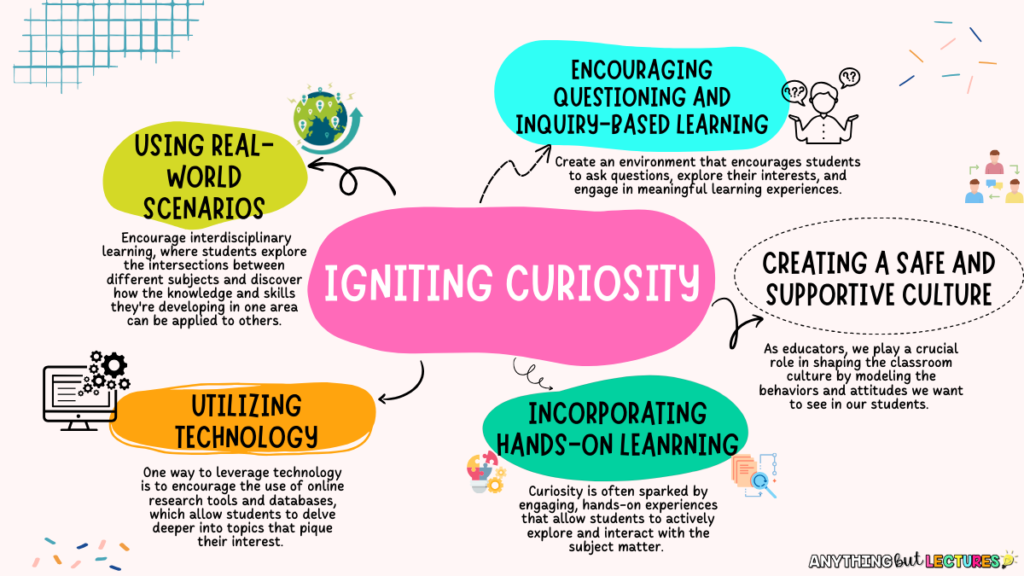
Another approach is to incorporate hands-on, experiential activities that allow students to engage with the subject matter in a more tangible and interactive way. This might involve conducting science experiments, creating art projects, or participating in field trips and community-based learning experiences. These activities not only capture students’ attention but also help them make deeper connections between the content and their own lived experiences, ultimately fueling their curiosity and desire to learn more.
Utilizing technology to enhance curiosity and exploration
In today’s digital age, technology has become an invaluable tool for fostering curiosity and exploration in the classroom. By incorporating a range of digital resources and platforms, we can provide students with access to a wealth of information, facilitate collaborative learning, and create opportunities for self-directed exploration.
One way to leverage technology is to encourage the use of online research tools and databases, which allow students to delve deeper into topics that pique their interest. By guiding students in the effective use of these resources, we can help them develop essential information literacy skills and empower them to become independent learners.
Another powerful application of technology is the use of interactive, multimedia-rich learning experiences. Tools such as virtual reality simulations, educational games, and interactive visualizations can transport students to new worlds, immerse them in complex concepts, and spark their curiosity to explore further. By incorporating these technologies into the classroom, we can create engaging and memorable learning experiences that inspire students to ask questions, make connections, and develop a deeper understanding of the subject matter.
Building connections between subjects and real-world scenarios
Fostering curiosity in the classroom is not just about exploring individual topics or subject areas; it’s also about helping students make connections between different disciplines and understand how the content they’re learning relates to the world around them.
One effective strategy is to encourage interdisciplinary learning, where students explore the intersections between different subjects and discover how the knowledge and skills they’re developing in one area can be applied to others. This might involve designing cross-curricular projects, organizing collaborative learning experiences, or facilitating discussions that explore the interconnectedness of various fields of study.
Additionally, it is important to help students understand the relevance of the content they’re learning to their own lives and the real-world challenges they may face. By providing opportunities for students to apply their knowledge to authentic, problem-solving scenarios, we can help them see the practical applications of what they’re learning and ignite their curiosity to explore further.
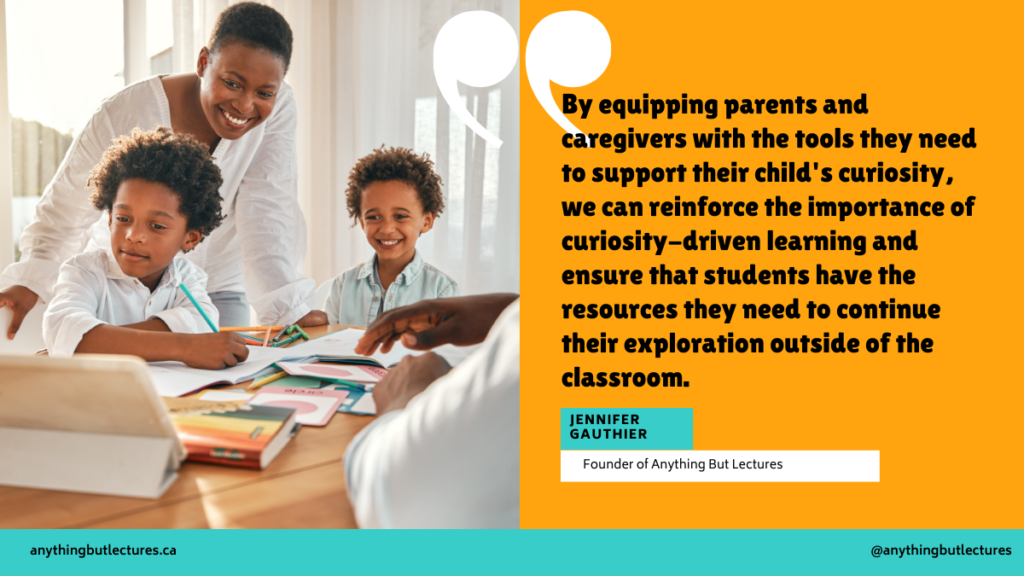
Engaging parents and caregivers in fostering curiosity at home
Fostering curiosity in the classroom is a collaborative effort, and it’s essential to engage parents and caregivers in the process. By working together, we can create a seamless learning environment that extends beyond the school walls and empowers students to continue their exploration and discovery at home.
One way to engage parents and caregivers is to provide them with resources and strategies for nurturing curiosity at home. This might include sharing reading lists, suggesting hands-on activities, or offering guidance on how to facilitate open-ended discussions and encourage questioning. By equipping parents and caregivers with the tools they need to support their child’s curiosity, we can reinforce the importance of curiosity-driven learning and ensure that students have the resources they need to continue their exploration outside of the classroom.
Furthermore, we can invite parents and caregivers to participate in classroom activities and events that showcase student learning and curiosity. This might involve inviting them to attend student presentations, participate in hands-on learning experiences, or even contribute their own expertise and perspectives to the classroom. By fostering this collaborative partnership, we can create a learning environment that is rich, diverse, and continuously fueled by the shared curiosity of all stakeholders.
Conclusion: Cultivating a lifelong love of learning through curiosity
In conclusion, fostering curiosity in the classroom is not just a pedagogical strategy; it is a fundamental responsibility that we, as educators, must embrace to prepare our students for the challenges of the 21st century. By creating an inquisitive learning environment that encourages questioning, exploration, and the pursuit of knowledge, we can ignite a lifelong love of learning in our students and empower them to become active, engaged, and responsible citizens.
Through the implementation of inquiry-based learning, hands-on activities, and the strategic use of technology, we can cultivate a classroom culture that celebrates curiosity and empowers students to take ownership of their own learning. By building connections between different subjects and real-world scenarios, we can help students understand the relevance and practical applications of what they’re learning, further fueling their curiosity and desire to explore.
Ultimately, the cultivation of curiosity in the classroom is not just about imparting knowledge; it is about nurturing the essential skills, mindsets, and dispositions that will enable our students to navigate the complexities of the future with confidence, adaptability, and a genuine passion for learning. As we embark on this journey together, let us embrace the power of curiosity and its transformative potential, shaping a generation of lifelong learners who are equipped to tackle the challenges of tomorrow and contribute to the betterment of our world.
